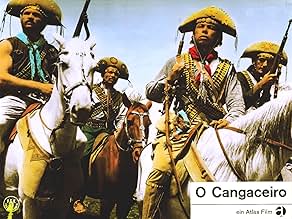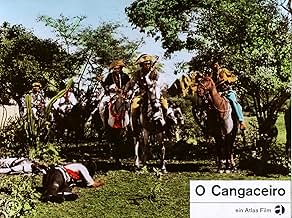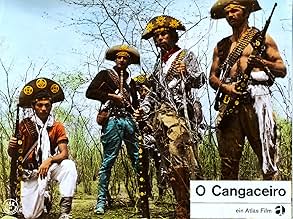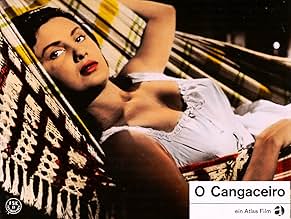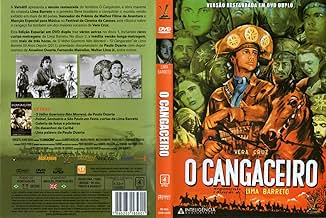अपनी भाषा में प्लॉट जोड़ें'Capitão', a bandit, terrorizes poor villages in the Northeast region of Brazil, looting and frequently killing with his armed gang, until he kidnaps and becomes attracted to a beautiful sch... सभी पढ़ें'Capitão', a bandit, terrorizes poor villages in the Northeast region of Brazil, looting and frequently killing with his armed gang, until he kidnaps and becomes attracted to a beautiful schoolteacher, creating discord in his group.'Capitão', a bandit, terrorizes poor villages in the Northeast region of Brazil, looting and frequently killing with his armed gang, until he kidnaps and becomes attracted to a beautiful schoolteacher, creating discord in his group.
- पुरस्कार
- 2 जीत और कुल 1 नामांकन
फ़ीचर्ड समीक्षाएं
In the times of the "cangaceiros" in the "sertão" (backcountry) in the North and Northeastern of Brazil, the cruel Capitão Galdino Ferreira (Milton Ribeiro) and his band abduct the school teacher Olívia (Marisa Prado), expecting to receive a ransom for her. However, one of his men, Teodoro (Alberto Ruschel) falls in love and flees with her through the arid backcountry chased by the brigands.
Along their journey, Olívia also falls in love with Teodoro and proposes him to leave the countryside and move to the city. But Teodoro loves also his land and tells that he would like to die in the backcountry where he was born.
"O Cangaceiro" is one of the best films of the Brazilian Cinema and the best produced by the Companhia Cinematográfica Vera Cruz. This film was written and directed by Lima Barreto, with dialogs of Rachel de Queiroz and is inspired in the story of the brigand Lampião and his band (http://en.wikipedia.org/wiki/Lampi%C3%A3o). The awesome cinematography in black and white discloses a magnificent introduction with backlight in the marauders.
On 12 May 1953, "O Cangaceiro" won the Cannes Film Festival in the category Best Adventure. In the wonderful soundtrack, highlights "Olê Muié Rendeira", sung by Vanja Orico. In accordance with the Wikipedia, this film was distributed by Columbia Pictures and sold to eighty (80) countries. It was exhibited in France for five consecutive years in the movie theaters. My vote is ten.
Title (Brazil): "O Cangaceiro" ("The Brigand")
Along their journey, Olívia also falls in love with Teodoro and proposes him to leave the countryside and move to the city. But Teodoro loves also his land and tells that he would like to die in the backcountry where he was born.
"O Cangaceiro" is one of the best films of the Brazilian Cinema and the best produced by the Companhia Cinematográfica Vera Cruz. This film was written and directed by Lima Barreto, with dialogs of Rachel de Queiroz and is inspired in the story of the brigand Lampião and his band (http://en.wikipedia.org/wiki/Lampi%C3%A3o). The awesome cinematography in black and white discloses a magnificent introduction with backlight in the marauders.
On 12 May 1953, "O Cangaceiro" won the Cannes Film Festival in the category Best Adventure. In the wonderful soundtrack, highlights "Olê Muié Rendeira", sung by Vanja Orico. In accordance with the Wikipedia, this film was distributed by Columbia Pictures and sold to eighty (80) countries. It was exhibited in France for five consecutive years in the movie theaters. My vote is ten.
Title (Brazil): "O Cangaceiro" ("The Brigand")
This film was the first brazilian production exhibited internationally after receive a prize of Best Music at a Cannes Film Festival. It was distributed accross the world by Columbia Pictures and was very successful at the box office.
I understand why foreign audiences still enjoy it, but for us brazilians it's very artificial when the hero leaves the semi arid background where the bandits live and penetrates a deep jungle to fight a jaguar etc, since those geographical regions are separated by hundred and hundred miles, like Arizona from Oregon. Anyway the music is amazing as the photography and the actor who plays captain Galdino ( Milton Ribeiro ). I believe that the main influence of director Lima Barreto was not the american westerns as most of people say, but the mexican films of Emilio Fernandez like "Enamorada". "O cangacero" is a good film, even if not not a great one and deserves the fame it has.
I understand why foreign audiences still enjoy it, but for us brazilians it's very artificial when the hero leaves the semi arid background where the bandits live and penetrates a deep jungle to fight a jaguar etc, since those geographical regions are separated by hundred and hundred miles, like Arizona from Oregon. Anyway the music is amazing as the photography and the actor who plays captain Galdino ( Milton Ribeiro ). I believe that the main influence of director Lima Barreto was not the american westerns as most of people say, but the mexican films of Emilio Fernandez like "Enamorada". "O cangacero" is a good film, even if not not a great one and deserves the fame it has.
I keep a very impressing souvenir of this picture I saw (6 times) in the fifties and would extremely appreciate if anyone could help me in finding a video copy. I much appreciated the crude and natural poetry of the film and,of course, the wonderful music. The photography also impressed me quite a lot and in my opinion Lima Barreto could have been influenced by Carol Reed. By all means, this film can certainly compete with the best "westerns" and should be given a chance to touch the actual generation by means of video, DVD etc. Although, since then, we have larger screens and color, this kind of picture in black and white proves, if necessary, that masterpieces exists without that.
Beautifully photographed, this Brazilian variation on the western is a strange mix. On the positive sides the images are very striking, and there are scenes of emotional intensity and violence, especially around the film's climax that are amazingly well staged and acted.
On the other hand, there's not a lot of depth to any of the characters or their motivations. They're more archetypes than full people. (It also falls into that cliché of the better looking an actor is, the better human being his character is.) Certainly that's common in this genre, but it doesn't mean I have to like it.
The story is nothing that new. Yet it's presented with a fierceness and focus that makes it very watchable. These bandit anti-heroes are hard men with hard hearts. Their violence is still disturbing, even by modern standards.
The much discussed music fell on both sides of the fence to me. The score, which includes a lot of songs, is sometimes quite a haunting partner to the striking images. But at other times, when the group of bandits whose story this is fall into singing and dancing in ways that feel more akin to a musical than a gritty, violent western, the effect was odd and disconcerting, almost unintentionally comic. But that might just be a cultural bias - it took me a while to get used to the musical numbers in Bollywood films, for example.
Overall, this was a film I was glad I got to see, and would like to see again for its imagery. Also, now that I understand its style, some of the cultural quirks would be less likely to throw me off balance.
On the other hand, there's not a lot of depth to any of the characters or their motivations. They're more archetypes than full people. (It also falls into that cliché of the better looking an actor is, the better human being his character is.) Certainly that's common in this genre, but it doesn't mean I have to like it.
The story is nothing that new. Yet it's presented with a fierceness and focus that makes it very watchable. These bandit anti-heroes are hard men with hard hearts. Their violence is still disturbing, even by modern standards.
The much discussed music fell on both sides of the fence to me. The score, which includes a lot of songs, is sometimes quite a haunting partner to the striking images. But at other times, when the group of bandits whose story this is fall into singing and dancing in ways that feel more akin to a musical than a gritty, violent western, the effect was odd and disconcerting, almost unintentionally comic. But that might just be a cultural bias - it took me a while to get used to the musical numbers in Bollywood films, for example.
Overall, this was a film I was glad I got to see, and would like to see again for its imagery. Also, now that I understand its style, some of the cultural quirks would be less likely to throw me off balance.
O Cangaceiro is a great film, with great artists and great songs. We can see a young Vanja Orico singing "Sodade Meu Bem Sodade", a composition by Zé do Norte, an extraordinary Brazilian composer. Now we can hear his songs through his son, the singer Toninho Di Lita, who makes another extraordinary performance, singing with his wife Inajara De Tanduí and his group Bando do Galo Doido, with great singers and musicians like Elísio Paschoal(Hermeto Pachoal's brother), Eliane Carneiro, Chaguinha Lima(Siri Atômico Band), Guto(Siri Atômico Band), Teresa Carvalho(Dama de Paus) and Will Tom(Dama de Paus), who sang with John Phillips in a Tour in Brazil. Toninho Di Lita is a great presence on theaters of Rio de Janeiro, singing songs made by his father and a lot of his own compositions. With new musical cloths Toninho Di Lita sings "Sodade Meu Bem Sodade", "Meu Pião", "Mulher Rendeira" and some hits of his own. "Manto Negro" is a beautiful composition who explains about the personality of the death. Toninho is always worried about education so he also makes performances to Universities and to Public Schools. More about him we can see on "www.orkut.com" - Toninho Di Lita. He is very nice with his fans.
क्या आपको पता है
- ट्रिवियाThe very first Brazilian film to compete at the Cannes Film Festival.
- कनेक्शनEdited into A Edição do Nordeste (2023)
टॉप पसंद
रेटिंग देने के लिए साइन-इन करें और वैयक्तिकृत सुझावों के लिए वॉचलिस्ट करें
विवरण
- चलने की अवधि1 घंटा 45 मिनट
- रंग
- ध्वनि मिश्रण
- पक्ष अनुपात
- 1.37 : 1
इस पेज में योगदान दें
किसी बदलाव का सुझाव दें या अनुपलब्ध कॉन्टेंट जोड़ें


